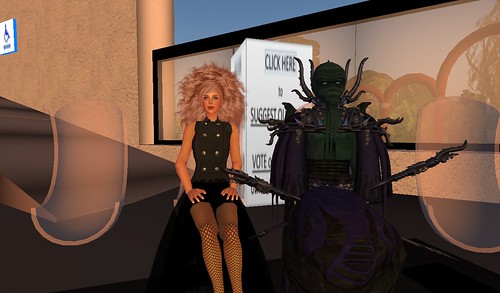
Location: Lunch Table with Physics Department
kudos to Kali for the image of Lovecraftian Iggy
Rule One: Never show colleagues that you dress like a monster for Halloween, even if it's in a virtual world. Rule One B: Spell "virtual" correctly in your post's title (fixed 11/2/10!).
I often get the variation of the same question from my colleagues in Physics, as well as from a few mathematicians, with whom I have lunch. "So, what is happening with your avatar?"
The line is usually delivered with a crooked smile, as if a humanist can at least be funny with his research topic, if not serious.
My science and math colleagues do realize that lots of good simulation can be done in 3D, including inside virtual worlds. They would be an "easy sell" but what about Deans, Department Chairs, and I.T. administrators? That will be the topic this week at the Virtual Worlds Roundtable's meeting on the Montclair State University virtual campus. We begin Thursday at 2:30 pm SL Time and will chat for an hour. Teleport link:
http://slurl.com/secondlife/Montclair%20State%20CHSSSouth/129/158/22
I have a few other "ground rules" I employ. I'm going to toss them onto the roundtable Thursday, but here they are:
- Avoid triumphalist discourse. Present VWs as a promising new technology, not the greatest innovation since fire. Explain that virtual worlds are not games, but that they use a game engine to let educators build simulations.
- Note that there are some activities, such as exploring a simulation and interacting with it, that cannot be done without an avatar. Show them, for instance, pictures of the Virtual Theorists Project at Montclair State.
- Point to the Canadian Border Crossing Project and in-world work by health professionals as examples of good in-world pedagogy, and note the Journal of Virtual World Research as a peer-reviewed publication.
- If appropriate, point to your grid as not containing adult content. If on a grid where hanky-panky exists, get the students to sign a waiver and present this to dubious colleagues.
- For face-to-face courses, do not emphasize in-world office hours when talking about a virtual world. I let my students know that they can IM me or visit during SL office hours, but that I'll also be at my physical office.
My audience liked that, and so will yours. Come by Thursday to share stories of what worked for you, or come by to hear others' stories.
3 comments:
a nice VW example is Texas State Technical College which has a programme ending in an Associates degree that is fully done in-world
All very good advice, sir. Nice work.
I would also underline "Avoid triumphalist discourse" about a million times. I've been in mny meetings where I've seen folks nosedive because they started doing this.
My WORST mistake was to show colleagues interested in SL video of my avatar goofing off while dressed like one of Wynx Whiplash's gorillas.
It's so damned easy to get carried away because, after all, these spaces are FUN. That was in 2007 and I think I pretty much torpedoed a lot of ships right there. Had I shown something like walking through the International Spaceflight Museum or Svarga I'd have won over some doubters.
But I've learned! No ape suits for presentations.
Post a Comment